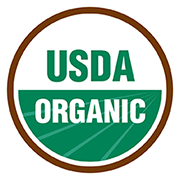
WHY CERTIFIED ORGANIC?
The term “certified organic” cannot be used casually. In this country, there are strict guidelines set up by the United States Department of Agriculture (as well as private certifying agencies) in order to authorize a facility to use the term “certified organic.” And being part of the organic culture demands a significant commitment to the entire system.
In today’s market people use the terms “all natural,” “organic” and “certified organic” interchangeably, when there really is a significant difference. Only “certified organic” has been approved by an accredited 3rd party agency after a thorough study of the entire process of growing the ingredients and manufacturing the final product to ensure that all steps have been performed within the strict guidelines.
In order to qualify as “certified organic,” all products must adhere to the following standards:
Crops must be grown without the use of artificial fertilizers or pesticides.
There is generally a required conversion period to organic methods, being two years (for ground crops) or three years (for perennials).
In order to break the cycles of pests and diseases, appropriate crop rotation is practiced for ground crops, which also helps to maintain soil fertility and structure.
No post-harvest chemical treatments are allowed.
Fertility is provided by natural organic manures, composts and fertilizers — the use of synthetic chemicals is prohibited.
The use of genetically modified (GM) seeds or other materials is not permitted (non-GMO).
During the production phase, all organic producers must:
Be certified by a recognized certification body and undergo a rigorous annual inspection by qualified inspectors.
Adhere to very strict standards that cover every aspect of food production, such as growing, packaging, processing and transport.
Maintain fully audited records of every stage of production to ensure complete traceability from farm to table.
Provide official certification numbers or logos of each certification body on the packaging, as this is the consumer’s guarantee of authenticity.
If foods are to be produced, the manufacturers must also be:
Certified by an organic certification body.
Keep all ingredients used in organic products separate from ingredients for use in conventional products at all times.
Maintain detailed routine records, including cleaning and processing schedules, which must be made available for audit by certification inspectors at all times.
The stringent controls associated with the production and processing of organic products ensure consistent adherence to guidelines set up by the recognized certification bodies.
The required 3rd-Party verification statement (as specified by USDA NOP) is shown on the back of every bag of certified organic Harrison’s Bird Foods.
The U.S. Department of Agriculture has put in place a set of national standards that food labeled “organic” must meet, whether it is grown in the United States or imported from other countries. After October 21, 2002, when you buy food labeled “organic,” you can be sure that it was produced using the highest organic production and handling standards in the world.
Organic agriculture is an ecological production management system that promotes and enhances biodiversity, biological cycles and soil biological activity. It is based on minimal use of off-farm inputs and on management practices that restore, maintain and enhance ecological harmony.
“Organic” is a labeling term that denotes products produced under the authority of the Organic Foods Production Act. The principal guidelines for organic production are to use materials and practices that enhance the ecological balance of natural systems and that integrate the parts of the farming system into an ecological whole..
Organic food handlers, processors and retailers adhere to standards that maintain the integrity of organic agricultural products. The primary goal of organic agriculture is to optimize the health and productivity of interdependent communities of soil life, plants, animals, people and the environment in general.
Organic food is produced by farmers who emphasize the use of renewable resources and the conservation of soil and water to enhance environmental quality for future generations. Organic food is produced without using most conventional pesticides; fertilizers made with synthetic ingredients or sewage sludge; bioengineering (GMO); or ionizing radiation. Before a product can be labeled “organic,” a government-approved certifier inspects the farm where the food is grown to make sure the farmer is following all the rules necessary to meet USDA organic standards. Companies that handle or process organic food before it gets to your local supermarket or restaurant must be certified too.
What does “certified organic” mean?
“Certified organic” means that a non-profit, state or private certification organization, accredited by the United States Department Of Agriculture (USDA), has verified that products labeled as “organic” meet strictly defined organic standards.
Why is “certification” important?
Provides for product differentiation
Ensures product’s value
Protects consumers from fraud
Boosts consumer confidence
The National Organic Program requires certification of agricultural products making an organic label claim
What is the National Organic Program (NOP)?
The National Organic Program (NOP) is a new federal regulation created by the USDA to: – Develop and implement national standards governing the marketing of agricultural products as organically produced – Facilitate commerce in fresh and processed food that is organically produced – Ensure consumers that such products meet consistent standards. Visit the USDA’s official National Organic Program website
How can I tell organically produced products from conventionally produced items?
You must look at package labels. Along with the national organic standards, USDA developed strict labeling rules to help consumers know the exact organic content of the food they buy. The USDA Organic seal also tells you that a product is at least 95 percent organic.
No GMOs
Products containing GMOs (Genetically Modified Organisims) genetically engineered crops etc. can not be certified organic. Does “natural” mean organic?
No. Natural and organic are not interchangeable. Other truthful claims, such as free-range, hormone-free, and natural, can still appear on food labels. However, don’t confuse these terms with “organic.” Only food labeled “organic” has been certified as meeting USDA organic standards.
Harrison’s, pet birds and organics?
Parrots are well known to be especially sensitive to environmental toxins, such as certain metals, chemical cleaners, and overheated plastic-coated cookware. Chemicals that normally are only irritating to humans and other animals can be extremely toxic to parrots. Yet little thought is given to the potential cancers, neurological problems, hormonal imbalances, allergies and disruptions of their fragile immune systems that may be attributed directly to pesticide residues on foods that parrots ingest or to the inherent dangers of commonly used pet food preservatives such as Ethoxyquin.
The EWG (Environmental Working Group) concluded that more than half of the total dietary risk from pesticides was concentrated in just 12 foods from the produce section of the supermarket: strawberries, bell peppers, spinach, cherries, peaches, cantaloupe, celery, apples, apricots, green beans, grapes and cucumbers.
Organic is the answer. The use of the USDA Organic seal on Harrison’s products designates that third party organic certifiers, accredited by The USDA have confirmed that Harrison ‘s Bird Foods meets the guidelines specified in The National Organic Program. This is the same USDA Organic seal that you will find on certified organic products sold at your local grocery store or natural foods market. Harrison ‘s Bird Foods are made from crops grown under strict organic specifications. The formulas are created, packaged and stored (at the HBDdistribution facility) under these strict specifications.
Organics and the environment?
Conventional farming techniques have incorporated chemical pesticides for many years. In the beginning it was believed that these pesticides were the only way to maintain high crop yields. Not much thought was given early on to the cumulative dangers of these poisons as they were continuously being fed into the earth. Pesticides can cause serious environmental problems. Many pesticides are highly toxic to aquatic life. Pesticide pollution can be driven by rainfall, with contamination of rivers and groundwater occurring from water draining off land or infiltrating to the water table. We are concerned about pesticide residues in water and the effects of pesticides on wildlife. The increased use of pesticides is one aspect of a general intensification of agriculture over the past fifty years. As a consequence of the increased use of pesticides, the number of farmland birds has declined. Evidence suggests that certain pesticides that find their way into water can interfere with endocrine (hormone) systems, for example affecting fertility and reproduction in fish, and leading to developmental changes.
The US Migratory Bird Copuncil estimates that of the roughly 672 million wild birds exposed annually to pesticides on U.S. agricultural lands, 10% or 67 million are killed.
Organic farming, or sustainable agriculture, is the first step toward moving away from this dangerous trend. Proper crop rotation breaks the cycles of pest and disease problems and balances the nutrient demands of specific crops. Alternative pest controls, such as certain insects or plantings, are incorporated into agriculture. The result is a safe, fertile and biologically diverse ground soil without the dangers of pesticide runoff.
Suggested online resources to learn more about organics/environment: The Rachel Carson Council
For more detailed information on the USDA organic standards, visit http://www.ams.usda.gov/nop call the National Organic Program at 202-720-3252, or write USDA-AMS-TM-NOP, Room 4008 S. Bldg., Ag Stop 0268, 1400 Independence, SW, Washington, DC 20250.
Not Just Organic
In addition to following the strict organic guidelines specified by the USDA, Harrison’s has some high standards of our own to ensure the very best quality product for your bird.
• Premium WHOLE grains and other ingredients are contracted by HBD to be grown on fertile organic farms throughout North America.
• A third party organic certifier verifies the certification of the raw ingredients, making sure they meet the requirements designated under the USDA’s rules regarding organic certification.
• All grains and other ingredients are tested (via independent laboratory) throughout the manufacturing process for mycotoxins and rancidity.
• For the extrusion process, the ingredients are ground and thoroughly mixed. Then the various sized and formulated nuggets are extruded, toasted, cooled and then packaged under careful supervision.
• Our state-of-the-art packaging (the Harrison’s bag) protects the freshness of the products, which have only natural tocopherols as preservatives.
• The foods are shipped to and stored at the HBD Distribution Center in Brentwood, TN. Products remain in this climate-controlled environment until being shipped for customer orders.
